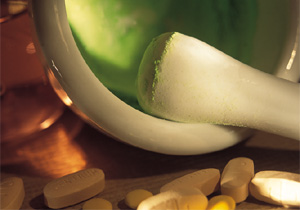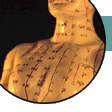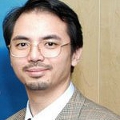Characteristics of Herbal Medicines
The actions of a herbal medicine is always not one but many. For
example, Calculus Bovis is not only a phlegm-eliminating agent but also
a heat-clearing one; Ganoderma Lucidum seu Japonicum not only can nourish
vital energy and blood, but also tranquilize the mind. Therefore, the
herbal medicines are difficult to be classified categorically, and the
classification mentioned in here is only based on their major
effects which are accepted conventionally.
Various properties and flavors of herbal medicines exert different
effects. This is an important theory of traditional Chinese pharmacology.
The Four Properties of Herbal Medicines
There are four properties of herbal medicines, i.e., cold, heat, warm
and cool. In general, the herbal medicines with warm and heat properties
are prescribed for cold-syndrome (e.g. aversion to cold, cold limbs,
pale tongue, slow pulse, etc.) and those with cool and cold characters
for heat-syndrome (e.g. fever, thirst, deep-colored urine, red tongue,
rapid pulse, etc.).
The Five Flavours
The herbal medicines are grouped under five flavors, i.e., acridness,
sweetness, sourness, bitterness and saltiness, which exert different
effects. Generally speaking, acridness serves to expel and to activate;
sweetness, to invigorate, to regulate and to moderate; sourness, to
astringe and to preserve; bitterness, to lower, to release and to dry;
saltiness, to soften and to purge.
Every herbal medicine possesses a specific character and flavor of
varying degrees. It is the combination of both that constitutes the
overall action of individual medicine. Hence, the clinical application
of herbal medicines, including the antineoplastic therapy, should be
based on this conventional theory. The property and flavor of each
herbal medicine are mentioned in this book as a reference for their
selection in clinical practice.
However, the component of individual herbal medicines is rather
complicated and its effect is usually multiple and not single. So,
besides the antineoplastic effect, the other effects are also presented.
And although the active antineoplastic ingredients have
been isolated from some of the herbal medicines, these ingredients may
exert effects other than antineoplastic. This multiple effect phenomenon
is also observed in some of the western mono-component antineoplastic
drugs. For example, cyclo-phosphamide can act on the various phases of
proliferative cells causing degeneration of DNA, RNA, enzymes and
protein and serves as a killer of tumor cells, and it is also an
immunosuppresant and applied for autoimmune diseases, Corticosteroids
can inhibit the lymphatic tissue and serves as an antineoplastic agent
for some tumors, but it also exerts antiphlogistic, immunosuppressive,
antishock and other effects, and is widely used in various diseases.
Therefore, the indications of each herbal medicine presented in this
site include the diseases other than neoplasms, so as to help
browsers to have a more complete understanding of their effects.
Some of the pharmacologic effects of herbal medicines are
also presented here. The information listed under this segment are mostly
obtained from the published literatures of the experimental animal
research, in vivo or in vitro, based on the principle of
antineoplastic pharmacology. It has been found that the antineoplastic
mechanism of herbal medicines is attributed to their actions chiefly
on the proliferative phase of the tumor cells. Some of them inhibit
the DNA synthesis, such as Fructus et Radix Camptothecae Acuminatae,
Indigo Naturalis, Fructus Bruceae, Rhizoma Zedoariae, Radix
Stephaniae Tetrandrae, etc., and some inhibit the synthesis of
protein, such as Semen, Cortex, Ramulus et Folium Cephalotaxi
Hainanensis, Mylabris, Radix Tylophorae Floribundae, etc. Only
a few selectively act on the mitotic phase of tumor cells, such
as Herba Catharanthi Rosei, Semen Coicis, etc.
Furthermore, some of the data are obtained from both animal
experiment and clinical observation on the non-specific
antineoplastic mechanism (chiefly the immunologic function),
indicating that the enhancement of bodily immunologic function
may be an important antineoplastic mechanism of herbal
medicines. It has been proved that many herbal medicines can
promote the phagocytosis of macrophages (e.g. Herba Hedyotis
Diffusae, Herba Sarcandrae, Ganoderma Lucidum seu Japonicum,
Poria, Radix Sophorae Flavescentis, etc.). Some can enhance
the cellular immunity (e.g. Radix Trichosanthis, Herba Taraxaci,
Bulbus Allii, etc.), and some can enhance the humoral immunity
(e.g. Radix Stephaniae Tetrandrae, Radix Actinidiae Chinensis, etc.).
Some can promote the activty of natural killer cells
(e.g. Radix Ginseng) while some can induce the production of
interferon (e.g. Radix Astragali, Radix Ginseng, Radix Actinidiae
Chinensis, etc.).
In summary, the herbal medicines achieves their antineoplastic
effect through various ways. Moreover, some medicine can bring on
several actions, for example, they may directly inhibit the growth
of tumor as well as indirectly exert an antineoplastic effect
by enhancing the bodily immunologic function. Generally they
elicit no significant adverse effect on the human body, and this
is a strong point of herbal medicine for antineoplastic treatments.
Nevertheless, research in this field is only preliminary and we
need further in-depth studies to obtain conclusive results.
"Provide treatment based on syndrome
differentiation" is an important principle for the clinical
application of herbal medicines. This principle should also be
followed in the antineoplastic treatment. In recent years, active
antineoplastic ingredients have been isolated from some herbal
medicines and are applied individually as various preparations
for injection, for oral or topical administration. However, many of
the crude herbal medicines are seldom used individually but are
usually combined together to make prescriptions following the
above-mentioned principle.
|

 This website is published, edited and designed by Raymond Cheng,
and reflects only and only his personal views and opinions in his individual capacity.
The information available at this website is not intended
directly or by implication to either diagnose or treat any
medical, emotional, or psychological condition or disorder.
It is also not intended to create a physician-patient relationship
between you and I or between you and Wyith Institute™ and The Office of Dr Raymond K K Cheng.
The information here is not a substitute for advice and treatment provided
by your physician or by another healthcare professional.
It is always recommended that consultation with local healthcare providers
be obtained for any of your specific health or medical concerns.
Furthermore, any products that can be purchased (yet you can see I don't have much
to sell here) through advertisers' banners or through links to other websites
are not either explicitly or implicitly given any warranty or endorsement
by me, my colleagues, Wyith Institute™ or any of its associated businesses.
This website is published, edited and designed by Raymond Cheng,
and reflects only and only his personal views and opinions in his individual capacity.
The information available at this website is not intended
directly or by implication to either diagnose or treat any
medical, emotional, or psychological condition or disorder.
It is also not intended to create a physician-patient relationship
between you and I or between you and Wyith Institute™ and The Office of Dr Raymond K K Cheng.
The information here is not a substitute for advice and treatment provided
by your physician or by another healthcare professional.
It is always recommended that consultation with local healthcare providers
be obtained for any of your specific health or medical concerns.
Furthermore, any products that can be purchased (yet you can see I don't have much
to sell here) through advertisers' banners or through links to other websites
are not either explicitly or implicitly given any warranty or endorsement
by me, my colleagues, Wyith Institute™ or any of its associated businesses.



 Thank you for visiting this TCM and acupuncture information website.
If you have previously been to this website, you might have
noticed that some of the pages on ancient historical ideas and
holistic thinkings related to Chinese metaphysics are temporarily taken offline.
This is because I will be revamping the whole website and be moving
those information into a new \"Ancient Chinese Culture\" section
so as to reflect a more current perspective on the interpretation
of some of the fundamental concepts as well as to include
some of the latest information in the area.
But if you have just found this website for the very first time, I welcome you again and
wish you could find what you require and, hopefully, you could also be benefitted
from reading the articles I published on this website.
Thank you for visiting this TCM and acupuncture information website.
If you have previously been to this website, you might have
noticed that some of the pages on ancient historical ideas and
holistic thinkings related to Chinese metaphysics are temporarily taken offline.
This is because I will be revamping the whole website and be moving
those information into a new \"Ancient Chinese Culture\" section
so as to reflect a more current perspective on the interpretation
of some of the fundamental concepts as well as to include
some of the latest information in the area.
But if you have just found this website for the very first time, I welcome you again and
wish you could find what you require and, hopefully, you could also be benefitted
from reading the articles I published on this website.